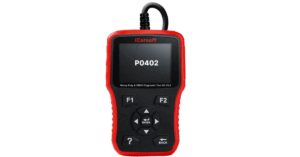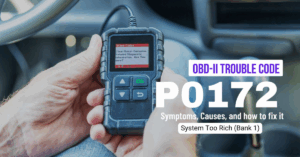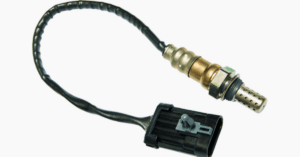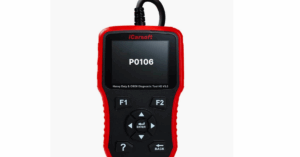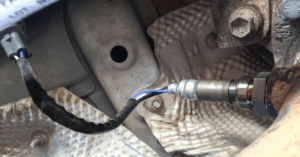The code P0300 indicates a “Random/Multiple Cylinder Misfire Detected”. This means that the engine’s computer has identified that one or more cylinders are not firing properly, resulting in incomplete combustion. This issue can lead to reduced engine performance and increased emissions.
Seeing a P0300 code pop up means you could be dealing with a tricky diagnosis and a multi-step repair—it’s not always a quick fix. In terms of severity, this OBD-II code is critical and will likely require the assistance of an automotive professional. Ignoring it could result in engine damage over time.
What Does Code P0300 Tell You?
When the P0300 code appears, it signals that the engine is experiencing random or multiple misfires. Misfires are caused when the fuel inside one or more cylinders fails to ignite properly, leading to incomplete combustion. This can occur for several reasons, such as ignition problems, fuel delivery issues, or mechanical faults like a blown head gasket or timing failure.
Unlike codes such as P0301 to P0308, which specify a misfire in a particular cylinder, P0300 refers to misfires happening randomly across multiple cylinders. Therefore, the code does not help pinpoint exactly which cylinder is affected, making it more challenging to diagnose the issue.

Drivability issues caused by a P0300 include vibrations, poor acceleration, and rough idling. If the misfire is severe, it may trigger the Check Engine Light (CEL) or cause it to blink. A blinking CEL typically indicates a serious problem that requires immediate attention to prevent engine damage.
Why the P0300 Error Code Is Important
A P0300 error code is more than just a simple nuisance. It can significantly affect your vehicle’s performance, fuel efficiency, and emissions. Here’s why it matters:
- Performance and drivability: Misfires lead to a rough-running engine, making your car feel unstable or sluggish, especially during acceleration. This can be frustrating and dangerous, particularly when merging onto highways or overtaking other vehicles.
- Fuel efficiency: When cylinders misfire, the engine burns fuel inefficiently, which means you’ll need to fill up your gas tank more often. The decreased fuel economy can add up over time, leading to increased operational costs.
- Increased emissions: Misfires lead to incomplete combustion, which increases the levels of harmful pollutants emitted by your vehicle. If the misfire is left unresolved, it could cause your car to fail an emissions test, particularly in areas with strict environmental regulations.

By addressing the P0300 code early, you can prevent further damage to the engine, save on fuel, and ensure your vehicle remains compliant with emissions standards.
Common Symptoms of the P0300 Code
1. The light may stay on or start blinking if misfires get worse. A blinking light often means an immediate risk to the engine. It’s the ECU’s way of alerting you to a serious ignition issue.
2. The car might vibrate or feel unstable when it’s stopped. This is due to uneven power delivery from misfiring cylinders. It can make the engine feel like it’s stumbling or struggling.
3. Acceleration may feel slow, uneven, or delayed when you hit the gas. Your car struggles to gain speed smoothly due to inconsistent firing. You’ll likely notice this when merging or overtaking.
4. The engine may crank longer than usual or not start at all. Misfires disrupt the ignition sequence, especially in colder starts. It feels like the engine is trying, but not catching properly.
5 . Fuel is burned inefficiently, causing frequent refueling stops. Misfires waste fuel by not fully combusting it in the cylinders. You’ll likely notice a drop in your average MPG.

6. Increased pollutants from poor combustion trigger test failures. The system can’t control emissions when misfires occur frequently. This can lead to legal or registration issues in many regions.
7. You may hear knocking, pinging, or ticking from the engine bay. These sounds come from uneven combustion or stressed components. It’s often a warning sign that internal damage could be forming.
Main Causes of P0300 Code
- Worn Spark Plugs or Bad Ignition Coils: The ignition system plays a crucial role in ensuring proper combustion. Worn spark plugs or faulty ignition coils can result in weak or inconsistent sparks, leading to misfires.
- Weak Fuel Pump or Clogged Injectors: Fuel delivery problems can also trigger the P0300 code. A weak fuel pump or clogged fuel injectors disrupt the flow of fuel to the engine, leading to lean conditions (too little fuel) or inconsistent fuel delivery, which causes misfires.
- Vacuum Leaks or Leaking Intake Gasket: Vacuum leaks, whether from cracked hoses or a faulty intake gasket, allow unmetered air to enter the engine. This alters the air-fuel ratio, causing the engine to run too lean, which can lead to misfires.
- Faulty Sensors: Sensors like the O2 sensor, Mass Air Flow (MAF) sensor, Crankshaft Position sensor, or Camshaft Position sensor provide critical data to the engine control module (ECM). If any of these sensors malfunction, they can send incorrect information to the ECM, causing the engine to misfire.
Images are for illustrative purpose only; credits belongs to Hillside Auto Repair. - Engine Issues: Low compression, worn piston rings, or a malfunctioning timing chain can lead to poor combustion and trigger the P0300 code. These mechanical issues often require more extensive repairs.
- Faulty EGR Valve or Catalytic Converter: A malfunctioning Exhaust Gas Recirculation (EGR) valve or clogged catalytic converter can disrupt the combustion process, leading to misfires.
- PCM Faults or Software Issues: In rare cases, the Powertrain Control Module (PCM) can have a software glitch, causing it to mismanage ignition timing or fuel delivery, resulting in misfires.
- Low Fuel Level or Chip Tuning Errors: Insufficient fuel pressure due to a low fuel level or issues caused by aftermarket chip tuning can lead to fuel delivery problems, which may result in misfires.
How to Fix the P0300 Code
Disclaimer:
The P0300 trouble code may vary across different vehicle makes and models, so always check for technical service bulletins (TSBs), recalls, and ensure you’re using the correct parts, part numbers, or upgraded components from the manufacturer or aftermarket sources. Some repairs may be covered under OEM warranty programs based on time or mileage, but most will be customer-paid if outside those limits.
For the best outcome, use a professional-grade scan tool (not just a basic code reader), or consult a qualified technician and trusted repair resources to complete the job safely using proper do-it-yourself methods outlined in your vehicle’s shop manual.
Step-by-Step Repair Process
Now that you understand the basics and risks, here’s a simple step-by-step approach to start fixing the P0300 code on your own:
Retrieve DTCs and Freeze Frame Data
To begin diagnosing a misfire, use an advanced scan tool to retrieve all stored Diagnostic Trouble Codes (DTCs), including the generic misfire P0300 code. Make sure to access the freeze frame data as well, as it captures crucial information about the engine’s condition at the moment the DTC was triggered.
This data often includes parameters such as engine speed, load, coolant temperature, and fuel trim. Analyzing these details helps pinpoint the root cause of the misfire.
Monitor Misfires During Idle
Once you’ve retrieved the codes, allow the engine to idle under similar conditions to when the DTC was stored. Most modern scan tools can display live data and misfire counters for each cylinder.
Pay close attention to any cylinders showing consistent or frequent misfire counts, as this indicates the problem area. Identifying the specific cylinders involved will guide you in conducting targeted inspections and repairs.
Check Oxygen Sensor Readings
Using the scan tool, monitor the voltage output from the oxygen sensors (O2 sensors) during idle and under load. Ideally, the upstream O2 sensor voltage should fluctuate between 0.1 and 0.9 volts. Abnormal readings may point to an incorrect air-fuel ratio, often caused by ignition issues or faulty spark plugs.
Compare the readings with manufacturer specifications to determine whether the sensors are functioning correctly.
Inspect for Leaks and Loose Parts
Conduct a thorough visual inspection of the vacuum hoses, intake manifold, and throttle body to check for any cracks, disconnections, or leaks. Even small vacuum leaks can cause rough idling and misfires.
Additionally, inspect the exhaust system for leaks and verify that the PCM (Powertrain Control Module) connectors are free from corrosion or looseness, as these issues can disrupt proper engine control.
Read More:
Mercedes-Benz Service A5: [ Service Cost & Checklist]
What is the Honda A1 Service? [ Checklist & Service Cost]
Test Spark with Tools
Using a spark tester, check for a consistent and strong spark on the affected cylinders. A weak or inconsistent spark can indicate issues with the ignition coil, spark plug wires, or the plugs themselves.
To verify electrical integrity, use a multimeter to measure the resistance of the spark plug and ignition wire. The resistance should match the manufacturer’s specifications to ensure proper conductivity.
Swap and Replace Spark Plugs

If the spark plug appears to function properly, swap it with one from a different cylinder. If the misfire shifts to the new location, the spark plug is likely faulty and should be replaced. If the misfire remains in the original cylinder, continue diagnosing the ignition coil, fuel injector, or compression issues. Always replace spark plugs in sets if they show signs of wear to maintain consistent performance.
Final Steps After Repair
Once you’ve completed the necessary repairs, use the scan tool to clear the trouble codes and reset the system. Then, turn off the ignition for about 30 seconds before restarting the engine. If the misfire issue is resolved, the Check Engine Light should turn off, and the engine should run smoothly.
Safety Reminders
-
Use Proper Tools
Always use the correct tools for diagnosing and repairing the P0300 code. A professional-grade scan tool is essential for accurately reading trouble codes and interpreting data.
-
Follow Manufacturer Guidelines
Refer to the vehicle’s service manual and technical bulletins for specific instructions on repairs. Don’t rely on general advice if the manual provides more detailed procedures.
-
Be Cautious When Handling Components
If dealing with parts like the PCM, ignition coils, or fuel injectors, ensure you handle them carefully to avoid damaging sensitive components or causing additional issues.
-
Consider Professional Help if Necessary
If you’re unsure or the issue persists despite your efforts, seek assistance from an automotive professional. Misdiagnosing or miss repairing the issue could lead to further damage.
FAQS
Q: How do I fix error code P0300?
A: To fix the P0300 code, start by inspecting and replacing spark plugs, ignition coils, and fuel injectors. Check for vacuum leaks and inspect critical sensors like the O2, MAF, and crankshaft sensors.
Q: What is the most common cause of a random misfire?
A: The most common cause of random misfires is worn spark plugs or faulty ignition coils.
Q: What sensors can cause a P0300 code?
A: Malfunctioning O2 sensors, MAF sensors, crankshaft sensors, and camshaft sensors are among the most common culprits.
Q: Can bad spark plug wires cause a P0300 code?
A: Yes, old or damaged spark plug wires can cause misfires, which may trigger the P0300 code.

Mian Hashir is a passionate automotive enthusiast and the lead author at Car Garagee, a website dedicated to providing in-depth car reviews, maintenance tips, and the latest news in the automotive world. With years of experience in the industry, Hashir combines his technical knowledge with a love for cars to deliver insightful and engaging content. Whether you’re a car owner or a curious reader, Mian Hashir’s articles help readers make informed decisions, from choosing the right vehicle to understanding how to keep it in top condition.




